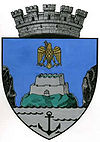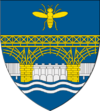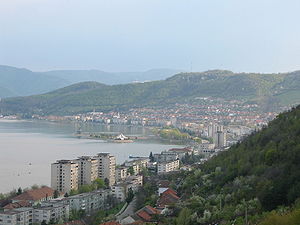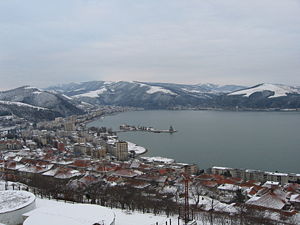- Orșova
-
For the village in Mureş County, see Gurghiu, Mureş.
Orșova — Municipality — 
Coat of armsLocation of Orșova Coordinates: 44°43′31″N 22°23′46″E / 44.72528°N 22.39611°ECoordinates: 44°43′31″N 22°23′46″E / 44.72528°N 22.39611°E Country  Romania
RomaniaCounty Mehedinți County Status Municipality Government - Mayor Constantin Bragaru (PDL) Population (2007) - Total 12,975 Time zone EET (UTC+2) - Summer (DST) EEST (UTC+3) Website http://primariaorsova.lx.ro/ Orșova (Romanian pronunciation: [ˈorʃova]; German: Orschowa, Hungarian: Orsova, Serbian: Оршава/Oršava, Bulgarian: Орсово, Polish: Orszawa, Czech: Oršava, Turkish: Adakale) is a port city on the Danube river in southwestern Romania's Mehedinți County. It is one of four localities in the county located in the Banat historical region. It is situated just above the Iron Gates, on the spot where the Cerna River meets the Danube.[1][2]
Contents
History
The first documented mention of its name was in 1150 under the Latin name Ursova. The name possibly comes from the Serbian name Uroš + Slavic -ova.[citation needed]
- The locality was the site of a Roman port in Dacia Malvensis Orșova, and the site of a castrum named Dierna.
- In 1925, a confusion done by scholar Nandor Fettich misplaced the important Magyar burial site discovered at Cheglevici into the Orşova region. Later, the location of that discovery, testifying to the presence of the Magyars since the early 10th century, was clarified for the archeological community.[3]
- King Ladislaus I of Hungary decisively defeated the Cumans near Orșova in 1091.
- It was a major border fortification in the Middle Ages.
- The city was captured by Suleiman the Magnificent in 1522.
- Orşova became part of the Habsburg Monarchy in 1687 at the start of an Ottoman-Habsburg War, but Ottoman forces recaptured it in 1690. The Treaty of Passarowitz gave the city back to the Kingdom of Hungary in 1718. Treaty of Belgrade gave the city back to the Ottoman Empire in 1739. Finally, The Treaty of Sistova gave the city back to the Kingdom of Hungary in 1791. The city remained in Hungary until the end of World War I, when it became part of Romania. It was included in the Mehedinți county during the administrative reform of 1968.
- The Hungarian Crown of Saint Stephen was buried near Orşova from 1848 till 1853.
- During the works at the Iron Gates, the old center of the town was flooded and Orșova was developed (1966–1971) on higher ground, including the southern side of the Almăj Mountains and the villages of Jupalnic, Tufari, and Coramnic. Also flooded then was the neighboring Ada Kaleh, with the scattering of the mostly Turkish community of the Danube island. Ada Kaleh and its inhabitants, as well as the ancient city, are still present in the memory of its surviving locals.
Economy
The town is a center for the extraction of bentonite, chromium, and granite. The industry is centered on energy production (the hydroelectric plant), shipbuilding and engine manufacturing, assembly parts for electricity production, textiles, and the processing of feldspar, asbestos, quartz, talc, wood, etc.
The Orșova shipyard was constructed in 1890 and like a small reparation shop for the vessels which participated to the navigable channel from Iron Gate Romania- Sip Yugoslavia and had a continuously development along time, with a spectacular development after the year 1991 when was changed the name and also the organizational profile.[4]
A wind farm is being developed in the city territory, on a hill nearby (at 4.5 km from the agglomeration); the first turbines became active there in 2009.[5] The project was partially expected to respond to the needs of the local community.[6]
Natives
- Ignat Bednarik (1882–1963), painter
- Alexander Fölker (1956), handball player
- Stefan Fröhlich, Luftwaffe general
References
- ^ http://www.orsova.ro
- ^ http://www.restromania.com/Geografie/CountyMehedinti.htm
- ^ D. Tănase - E. Gáll, Aplice de centură şi de îmbrăcăminte din secolul X p.Chr. din colecţia Muzeului Banatului Timişoara, Studii de istorie a Banatului (Timişoara), XXI, 2001, pp. 243-255.
- ^ http://www.snorsova.ro/html/about.html
- ^ http://www.green-report.ro/stiri/prima-turbina-eoliana-fost-montata-la-orsova
- ^ http://www.drobetaturnuseverin.net/parc-eolian-apropiere-de-orsova?page=1212
Cities Drobeta-Turnu Severin (county seat) · Orşova

Towns Communes Bâcleş · Bala · Bălăciţa · Balta · Bâlvăneşti · Braniştea · Brezniţa-Motru · Brezniţa-Ocol · Broşteni · Burila Mare · Butoieşti · Căzăneşti · Cireşu · Corcova · Corlăţel · Cujmir · Dârvari · Devesel · Dubova · Dumbrava · Eşelniţa · Floreşti · Gârla Mare · Godeanu · Gogoşu · Greci · Grozeşti · Gruia · Hinova · Husnicioara · Ilovăţ · Iloviţa · Isverna · Izvoru Bârzii · Jiana · Livezile · Malovăţ · Obârşia de Câmp · Obârşia-Cloşani · Oprişor · Pădina Mare · Pătulele · Podeni · Ponoarele · Poroina Mare · Pristol · Prunişor · Punghina · Rogova · Salcia · Siseşti · Şimian · Şovarna · Stângăceaua · Sviniţa · Tâmna · Vânători · Vânjuleţ · Vlădaia · Voloiac · Vrata
Categories:- Populated places in Mehedinţi County
- Cities in Romania
- Populated places on the Danube
- Czech communities in Romania
- Romania–Serbia border crossings
Wikimedia Foundation. 2010.




